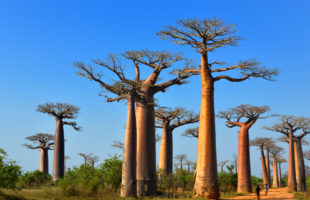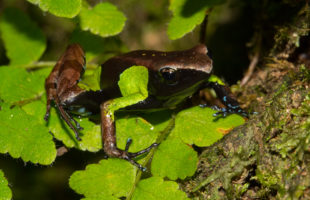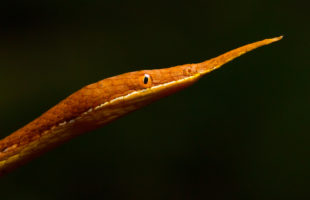Ihre Gesänge gehören zu den eindruckvollsten, die die Tierwelt zu bieten hat: Man kann die Stimmen der Indris (Indri indri) kilometerweit durch den Wald schallen hören, und sie tragen eine eigentümliche Traurigkeit mit sich. Angeführt und begonnen wird der Gesang stets vom Elternpaar einer Familie, das damit sein Revier absteckt, aber auch mit anderen Familien kommuniziert und vor Bedrohungen wie …
LesenDer Tomatenfrosch
1875 fiel dem französischen Naturforscher Alfred Grandidier ein knallroter, dicker Frosch auf einer seiner vielen Reisen nach Madagaskar in die Hände. Gebracht hatte ihn ein Landsmann, der sich als Händler an der Ostküste niedergelassen hatte: Ein gewisser Herr Guinet. Der weit gereiste Grandidier nahm Tiere der noch unbekannten Art mit nach Frankreich und beschrieb sie dort erstmals. Warum ihm der …
LesenThe second smallest reptile on Earth
It can sit on a matchstick without a problem, and you could almost think that the slightest breeze will blow the fragile pipsqueak off the match: Brookesia micra, the second smallest* reptile on Earth. Despite its few millimeters body lengths, the little, brown leaf chameleon has everything other chameleons need for life, too: Eyes moving to every possible direction, a …
LesenThe country of Baobabs
What would Madagascar be without its giant landmarks, the mighty baobabs? Over here, they might be known as monkey bread, and have been famous as photo motives and in literatures for centuries. These huge trees, whose roots seems to grow into the sky, enchant everyone, and many baobabs are told to possess magic power. Madagascar has not less than seven …
LesenGuibé’s mantella
You think poison dart frogs exist only at the Amazon? You are miles out! Madagascar has amphibians very similar to those, the Mantellas or coloured frogs. Like poison dart frogs, Mantella frogs produce a poison secreted via their skin, but it is completely harmless for human beings. Genetically, the Madagascan Mantellas are not related to poison dart frogs. Mantella frogs …
LesenAgainst the tide: A climbing Mantella
Actually, Madagascan Mantellae all look very similar: Striking colours, small and slender, terrestrial frogs. But one steps out the line: The climbing Mantella (Mantella laevigata). This Mantella was described in 1913 by British zoologists Paul Ashleyford Methuen and John Hewitt, who did a seven months lasting expedition to Madagascar two years ago. The climbing Mantella grows up to maximally 29 …
LesenThe carnivore among plants
Carnivorous plants in Madagascar? Yes, there are! Two species of pitcher plants (Nepenthes madagascariensis and Nepenthes masoalensis) solely exist on the big island. You can find them in open, sunny areas on humid sandy soil along Madagascar’s east coast. In northern direction, they occur until Antongil bay and in southern direction until Tolagnaro (French Fort Dauphin). Mostly, large populations are …
LesenFascinating predators: Idolomorpha madagascariensis
Praying mantises are ill-reputed as man eating and murderous within the animal kingdom. And the triangular-shaped head lets them look like real aliens. But there is more to it than that! They are fascinating insects, and an especially impressing species among them is Idolomorpha madagascariens from Madagascar. It exceeds most Malagasy praying mantis with a body length of filigree seven …
LesenThe left-handed lemurs: Coquerel’s sifakas
With their typical teddy bear-like appearance, they wrap many travellers around their fingers: Coquerel’s Sifakas (Propithecus coquereli) wear a plush, snow-white fur, whereby the upper sides of the arms and thighs as well as the chest are deeply chocolate brown colored. With up to a half meter head-torso-length – in addition, another half meter tail – as well as approximately …
LesenThe Malagasy leaf-nosed snake
A nose that somehow resembles a frayed leaf and can be bent, and an elongated body: these are the most outstanding characteristics of the Langaha madagascariensis, one of many bizarre animals in Madagascar. The purpose of the bizarre nasal process has not yet been clarified. In males, it looks more like a Pinocchio nose than a leaf. The name of …
Lesen MADAMAGAZINE Your Magazine about Madagascar
MADAMAGAZINE Your Magazine about Madagascar










